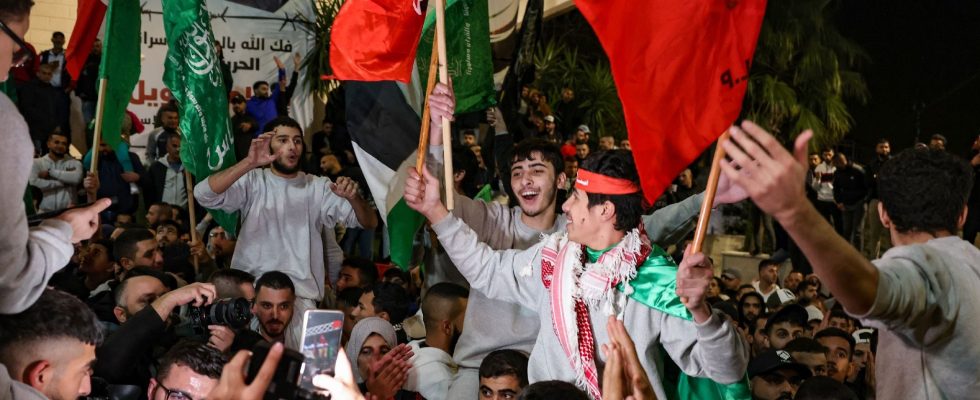On Saturday evening, in the streets of Ramallah, vehicles marked International Committee of the Red Cross (ICRC) tried to make their way through the crowd. In the dark for several hours, cheers in the name of “Ezzedine! Ezzedine!” — the armed wing of the Hamas terrorist movement, the Ezzedine al-Qassam brigades – punctuate the gatherings organized this Saturday, November 25 in the West Bank.
Several thousand people came to celebrate, green Hamas flags in hand, the release of Palestinian prisoners incarcerated in the jails of the Jewish state. A total of thirty-nine were released, including six women and thirty-three minors. An early release, made possible by the agreement concluded between Israel and Hamas.
Sealed under the aegis of Qatar, the text provides for the release of 50 hostages held by Hamas terrorists in exchange for 150 Palestinians held in Israeli prisons. A sort of bargaining chip accepted by the State of Israel, which said it was “determined to bring back all (its) hostages”, in order to obtain the release of around fifty of its nationals kidnapped by terrorists on the 7th. last October.
Varied profiles
According to information provided by Israeli prison authorities, the Palestinian prisoners concerned were held in three prisons, including two in the occupied West Bank and one in Israel. Their profile varies. And some may seem surprising to say the least. While most of them were serving sentences for so-called “minor” offenses, such as stone throwing or advocating terrorism, there were a few who were charged with very serious offenses. Murder attempts in particular.
This is the case of Marah Bakir, 24, sentenced to eight years in prison for attempting to assassinate an Israeli border guard. “I am happy, but my release came at the price of the blood of the martyrs,” the young woman testified to our colleagues at AFP. And to justify his actions by the Israeli bombings in Gaza: “I spent the end of my childhood and my adolescence in prison, far from my parents and their hugs, but that’s how it is with a State that oppresses us and Don’t leave any of us alone.”
An icon of the Palestinian cause among the released detainees
A profile reminiscent of that of Malek, a year his junior, who was incarcerated in February 2016 after trying to stab a police officer in Jerusalem. Or that of Nurhan Awad, imprisoned since the age of 17 for trying to stab passers-by, including an Israeli soldier. He was then sentenced to thirteen and a half years in prison. Less than Shorouq Dwayyat, who received the longest prison sentence among the 8,000 Palestinian prisoners in Israel. Accused of being the author of a knife attack against a settler in 2015, the young woman was sentenced to sixteen years in prison.
But among the released prisoners, one particularly stood out. This is Israa Jaabis, who through a photo which shows her face partially burned in an Israeli court, has become the icon of pro-Palestinian demonstrations. In 2015, she was convicted of detonating a gas canister she was carrying in her vehicle. An “accident” according to her, which in addition to having burned 50% of her body, injured a police officer. Released this weekend, this 39-year-old mother told journalists that she was “ashamed to talk about rejoicing when all of Palestine is hurt.” “They must release everyone,” she further pleaded.
Towards an extension of the truce?
While released prisoners denounce “difficult” detention conditions, particularly since the resurgence of the Israeli-Palestinian conflict, 8,000 Palestinians are still detained by the Jewish state, according to several Palestinian organizations. During the night from Sunday to Monday, the Hamas terrorist movement announced that it was “seeking to extend the truce beyond its four days”, with the aim of “increasing the number of prisoners released”. A proposal to which the Palestinian movement subscribes, according to information collected by our colleagues at AFP. And who could thus record the extension of “two to four days” of the truce in the coming hours.
Note that a provision of the agreement provides for its renewal in order to free around ten hostages daily in the hands of Hamas, in exchange for the release of around thirty Palestinian prisoners. An imbalance which could, however, encourage Benjamin Netanyahu, whose objective remains “the elimination of Hamas”, to quickly resume fighting. This, despite pressure from Israeli public opinion, which is calling on its government to make the release of the hostages the number one priority.
